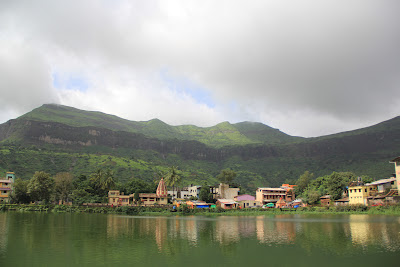Shirdi is just a 2 hour drive from Nashik. The town occupies about 4 kms along the road connecting Malegaon to Ahmadnagar. The obvious highlight of the town is Saibaba Mandir. No matter what day or time you go here, you will always find thousands of devotees vying for a look of the serene face of Saibaba's statue. His birth details are unknown and also the religion he was born into isn't known. Even his real name isn't known. It is believed that he got off a bus at Shirdi when he was around 16 years old and the temple priest, Mahalsapati welcomed him as Sai. This became his name hence forward. Even at such a young age, he practiced hard penance and was regularly visited by the religiously inclined. However, some people even considered him mad and threw stones at him. He meditated for long hours under a Neem tree and often wandered in forests around Shirdi. Later he took up residence in an old and dilapidated mosque called Dwarkamai, where he kept a sacred fire, from which he gave sacred ashes to his guests. This ash had healing properties and he also performed the function of hakim, while imparting spiritual teachings to his disciples. His worship procedures were a mix of Hinduism and Islam and his most popular preaching is "Sabka Maalik ek hai" or "God is one". It is believed that he also performed many miracles such as curing the incurably sick and is subsequently worshiped as an incarnation of god.
We reached Shirdi around 6 pm on Thursday. After some rest in our hotel, I found out that a palki procession is carried on Thursdays. Thursday is considered more sacred by Sai devotees. Even though we were pretty exhausted, we decided to pay a visit to Sai temple at around 8 pm. Upon reaching there and seeing the size of the queue, we fell into the trap of a shopkeeper who promised us easy way into the temple if we purchase stuff for puja from there shops. Avoid them if you go there. Finally after 2 hours of standing in the queue and moving from one hall to the other, we reached the main hall where the highly revered statue is there. However, it was 10:30 pm and darshan time was over. A few minutes of standing at the back of the hall from where the statue was hardly visible and we were literally pushed out by the security staff there. I was very disappointed by their behavior. Back at hotel, we slept immediately due to exhaustion.
 |
| Humans working on Kolhu |
Next morning, we went to Shani Temple at Shinganapur which is about 65 kms from Shirdi towards Aurangabad. A visit to Shinganapur can be done as a day visit from Shirdi in about 5 hours. The deity here is Swayambhu in the form of an imposing black stone. It is believed that this stone was discovered by a shepherd and the stone started to bleed when the shepherd poked a pointed rod into it. Later, Shani dev appeared in his dream. He told the shepherd that he is Shanaishwara and this is his Swayambhu form. He also told that the whole hamlet will have no fear of burglars or thieves. To this date, there are no doors in any houses or shops within a 1 km radius of the temple.
 |
| Entrance to Shani Mandir |
After coming back to Shirdi, my mother coaxed me into going to the Saibaba temple again. Personally, I didn't feel like going again due to the treatment received a day before. Thinking that yesterday must have been more crowded for it was a Thursday, we went into the never ending queue again. This time we went earlier so as to ensure that we reach the main hall before darshan time finishes. Though the queue was similar in length as yesterday, but it moved a lot faster and we were inside the prayer hall in about an hour. Some more time and we were in front of Saibaba's serene face exuding calmness that ran through my body. Even though security staff were pushing us to move here as well, but one can move a bit backwards in the corridor and stay there for a bit longer. Their is a sense of calmness and serenity while you look at the statue even though you are crowded by thousands of devotees. Standing there for a few minutes, I totally forgot the disappointment of the day before and felt blessed to be there.
Next morning, we were to leave for Bhimashankar temple so we slept early again.
TIPS:
1. Try visiting Saibaba temple on weekdays as weekends would be too crowded. Unless you specifically want to, avoid Thursdays as well.
2. Best time during the day to visit would be around 4 am when you can attend Kakkad Aarti with comparatively lesser crowds.
3. Also visit Dwarkamai Mosque and Chawari once you are out of the main temple.
4. Don't fall into the trap of shopkeepers promising you direct entry to the main hall. Their is no direct entry unless you hold a VIP pass.
P.S. Post on Bhimashankar will be up within next 4 days.






















